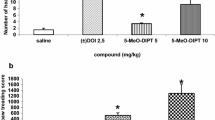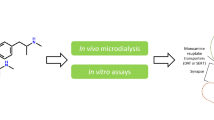Abstract
Three serotonin (5-HT) neurotoxins,p-chlorophenylalanine (PCPA, 125 and 250 mg/kg, i.p.),p-chloroamphetamine (PCA, 10 mg/kg, i.p.) and 5,7-dihydroxytryptamine (5,7-DHT, 200 µg/rat, i.c.v.) were used to examine whether depletion of central 5-HT has an effect on central dopaminergic (DA) neuronal activities or on prolactin (PRL) secretion. Adult ovariectomized Sprague-Dawley rats primed with estrogen (polyestradiol phosphate, 0.1 mg/rat, s.c.) were treated with one of three neurotoxins and then decapitated in the morning after 3–7 days. Blood sample and brain tissues were collected. The acute effect of PCA (from 30 to 180 min) was also determined. The concentrations of 5-HT, DA and their metabolites, 5-hydroxyindoleacetic acid and 3,4-dihydroxyphenylacetic acid, in the median eminence, striatum and nucleus accumbens were determined by HPLC-electrochemical detection. All three toxins significantly depleted central 5-HT stores by 11–20%. Except for PCPA, neither PCA nor 5,7-DHT had any significant effect on basal DA neuronal activities or PRL secretion. PCA also exhibited an acute effect on the release and reuptake of 5-HT and DA. In summary, depletion of central 5-HT stores to a significant extent for 3–7 days did not seem to affect basal DA neuronal activity and PRL secretion.
Similar content being viewed by others
References
Aved AF. Precursor control of the function of monoaminergic neurons. In: Wurtman RJ, Wurtman JJ, eds. Nutrition and the Brain, vol 6. New York, Raven Press, 223–275;1983.
Axt KJ, Seiden LS. α-Methyl-p-tyrosine partially attenuatesp-chloroamphetamine-induced 5-hydroxytryptamine depletions in the rat brain. Pharmacol Biochem Behav 35:996–997;1990.
Baumgarten HG, Bjorklund A. Neurotoxic indoleamines and monoamine neurons. Annu Rev Pharmacol Toxicol 16:101–111;1976.
Ben-Jonathan N. Dopamine: The prolactin-inhibiting hormone. Endocr Rev 6:564–589;1985.
Benloucif S, Keegan MJ, Galloway MP. Serotonin-facilitated dopamine release in vitro: Pharmacological characterization. J Pharmacol Exp Ther 265:373–377;1993.
Bjorkum AA, Berge OG. The relative contribution of ascending and descending pathways inp-chloroamphetamine-induced antinociception. Pharmacol Biochem Behav 31:135–140;1988.
Bonhomme N, De Deurwaérdere P, Le Moal M, Spampinato U. Evidence for 5-HT4 receptor subtype involvement in the enhancement of striatal dopamine release induced by serotonin: A microdialysis study in the halothane anesthetized rat. Neuropharmacology 34:269–279;1995.
Bosler O, Joh TH, Beaudet A. Ultrastructural relationships between serotonin and dopamine neurons in the rat arcuate nucleus and medial zona incerta: A combined radiographic and immunocytochemical study. Neurosci Lett 48:279–285;1984.
Clemens JA, Rough ME, Fuller RW. Evidence that serotonin neurons stimulate the secretion of prolactin releasing factor. Life Sci 22:2209–2214;1978.
Commins DL, Axt KJ, Vosmer G, Seiden LS. Endogenously produced 5,6-dihydroxytryptamine may mediate the neurotoxic effects of para-chloroamphetamine. Brain Res 419:253–21;1987.
Fuller RW. Serotonin oxidation by rat brain monoamine oxidase: Inhibition by 4-chloroamphetamine. Life Sci 5:2247–2252;1966.
Fuller RW. Mechanism by which uptake inhibitors antagonizep-chloroamphetamine-induced depletion of brain serotonin. Neurochem Res 5:241–245;1980.
Fuller RW: Effects ofp-chloroamphetamine on brain serotonin neurons. Neurochem Res 17:449–456;1992.
Fuller RW, Henderson MG. Neurochemistry of halogenated amphetamines. In: Cho AK, Segal DS, eds. Amphetamine and Its Analogs: Psychopharmacology, Toxicology and Abuse. San Diego, Academic Press, 229–242;1994.
Garthwaite TL, Hagen TC. Evidence that serotonin stimulates a prolactin-releasing factor in the rat. Neuroendocrinology 29:215–220;1979.
Henderson MG, Perry KW, Fuller RW. Possible involvement of dopamine in the long-term serotonin depletion byp-chloroamphetamine and β,β-difluoro-p-chloroamphetamine in rats. J Pharmacol Exp Ther 267:417–424;1993.
Kiss J, Halasz B. Synaptic connections between serotonergic axon terminals and tyrosine hydroxylase-immunoreactive neurons in the arcuate nucleus of the rat hypothalamus. A combination of electron microscopic autoradiography and immunocytochemistry. Brain Res 364:284–294;1986.
Koe BK, Weissman A:p-Chlorophenylalanine: A specific depletor of brain serotonin. J Pharmacol Exp Ther 154:499–516;1966.
Lin JY, Mai LM, Pan JT. Effects of systemic administration of 6-hydroxydopamine, 6-hydroxydopa, and 1-methyl-4-phenyl-1,2,3,6-tetrahydroxypyridine (MPTP) on tuberoinfundibular dopaminergic neurons in the rat. Brain Res 624:126–130;1993.
Lynch CO, Johnson MD, Crowley WR. Effects of the serotonin agonist, quipazine, on luteinizing hormone and prolactin release: Evidence for serotonin-catecholamine interactions. Life Sci 35:1481–1487;1984.
Moore KE, Lookingland KJ. Dopaminergic neuronal systems in the hypothalamus. In: Bloom FE, Kupfer DJ, eds. Psychopharmacology: The Fourth Generation of Progress. New York, Raven Press 245–256;1995.
Muramatsu M, Tamaki-Ohashi J, Usuki C, Araki H, Chaki S, Aihara H. 5-HT2 antagonists and minaprine block the 5-HT-induced inhibition of dopamine release from rat striatal slices. Eur J Pharmacol 153:89–95;1988.
Pan JT. Neuroendocrine control of prolactin secretion: The role of the serotonergic system. Chin J Physiol 34:45–64;1991.
Pan JT. Neuroendocrine function of dopamine. In: Stone CW, ed. CNS Neurotransmitters and Neuromodulators: Dopamine. Boca Raton, CRC Press, 213–232;1996.
Pan JT, Gala RR. The influence of raphe lesions,p-chlorophenylalanine, and ketanserin on the estrogen-induced afternoon prolactin surge. Endocrinology 120:2070–2077;1987.
Pan JT, Yang ICH. Central administration of 8-OH-DPAT and mCPP stimulates prolactin secretion in ovariectomized, estrogen-treated rats: Lack of an effect on tuberoinfundibular dopaminergic neuron activity. Life Sci 58:1189–1194;1996.
Pan JT, Yang ICH, Liang SL: Differential effects ofp-chloroamphetamine and 5,7-dihydroxytryptamine on basal levels and diurnal changes of tuberoinfundibular dopaminergic neuron activity and PRL secretion. 79th Annual Meeting, The Endocrine Society, Minneapolis, 143;1997 (abstract).
Pilotte NS, Porter JC. Dopamine in hypophysial portal plasma and prolactin in systemic plasma of rats treated with 5-hydroxytryptamine. Endocrinology 108:2137–2141;1981.
Reader TA. Neurotoxins that affect central indoleamine neurons. In: Boulton AA, Baker GB, Juorio AV, eds. Drugs as Tools in Neurotransmitter Research. Neuromethods, vol 12. Clifton, Humana Press, 49–102;1989.
Roth BL, Meltzer HY. The role of serotonin in schizophrenia. In: Bloom FE, Kupfer DJ, eds. Psychopharmacology: The Fourth Generation of Progress. New York, Raven Press, 1215–1227;1995.
Rudnick G, Wall SC:p-Chloroamphetamine induces serotonin release through serotonin transporters. Biochemistry 31:6710–6718;1992.
Sanders-Bush E, Massari J. Actions of drugs that deplete serotonin. Fed Proc 36:2149–2153;1977.
Sharp T, Zetterstrom T, Christmanson L, Understedt U:p-Chloroamphetamine releases serotonin and dopamine into rat brain dialysates in vivo. Neurosci Lett 72:320–324;1986.
Sugita R, Terada K, Sekiya Y, Sawa Y, Momura S, Nakazawa T. Effect ofp-chloroamphetamine administration on monoamine metabolism in the rat nucleus accumbens and locomotor activity: Studies with intracerebral dialysis in freely moving rats. Brain Res 658:255–258;1994.
Tai MH, Teo KL, Pan JT. Serotonin-stimulated prolactin secretion may not involve the dopaminergic system. Chin J Physiol 33:345–352;1990.
Tuomisto J, Mannisto P. Neurotransmitter regulation of anterior pituitary hormones. Pharmacol Rev 37:249–332;1985.
Van de Kar LD, Bethea CL. Pharmacological evidence that serotonergic stimulation of prolactin secretion is mediated via the dorsal raphe nucleus. Neuroendocrinology 35:225–230;1982.
Weiner RI, Ganong WF. Role of brain monoamines and histamine in regulation of anterior pituitary secretion. Physiol Rev 58:905–976;1978.
Westfall C, Tittermary V. Inhibition of the electrically induced release of [3H]dopamine by serotonin from superfused rat striatal slices. Neurosci Lett 28:205–209;1982.
Author information
Authors and Affiliations
Rights and permissions
About this article
Cite this article
Yang, I.CH., Pan, JT. Effects of serotonin depletion byp-chlorophenylalanine,p-chloroamphetamine or 5,7-dihydroxytryptamine on central dopaminergic neurons: Focus on tuberoinfundibular dopaminergic neurons and serum prolactin. J Biomed Sci 6, 183–193 (1999). https://doi.org/10.1007/BF02255902
Received:
Accepted:
Issue Date:
DOI: https://doi.org/10.1007/BF02255902




